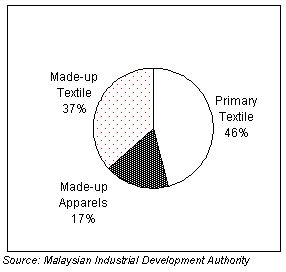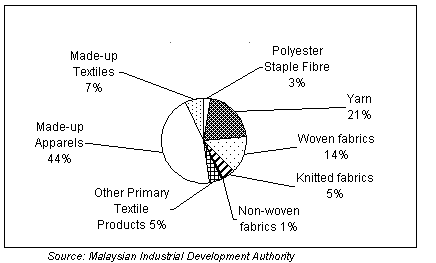|
Overview
Part 1 comprised understanding the textile & apparel industry, production process and global trade in textiles and apparel. Part 2 looked at development of world textile & apparel regulations, voluntary export restraint, General Agreement on Tariffs and Trade, STA & LTA (Cotton Arrangements), the Multi-Fibre Arrangement (MFA), Agreement on Textiles & Clothing and Rules of Origin in the textile & apparel industry. Part 3 analysed the Impact of the MFA, birth of new players, web of protectionism, quotas and factors affecting demand for textiles and apparels. Part 4 reviewed Malaysia’s textile and apparel industry in terms of structure and players, the primary & made-up textiles sub-sector, the apparel sub-sector, the players, the free industrial zones, duties and tariffs and licensed manufacturing warehouse, import duties & tariffs and textile & apparel production in Malaysia.
5.0 Investments received by Malaysia’s textile & apparel industry
In 2003, 37 investment applications for the textile and apparel industry were received, with RM225.4 mln worth of investment coming from domestic investors and RM82.4 million from foreign investors. Out of this, 34 projects worth RM292.7 mln were approved, with domestic investment representing 73% of the approved projects and the balance being foreign investment.
Of the 34 approved projects, 8 are involved in the primary textile segment (polymerisation, spinning, weaving, knitting, and dyeing and finishing of fabrics), with investment amounting to RM134.5 mln; 9 in the made-up apparels segment worth RM50.9 mln (involves producing under-apparels, bio-ceramic FIR made-up apparels, t-shirt, blouses, trousers, sportswear and uniforms); and 17 in the made-up textile segment with investment of RM107.3 mln (producing carpets, erosion control mat, disposable diapers, and tufted carpet). Out of the same 34 approved projects, 20, worth RM179.2 mln, were new projects, while 14 worth RM113.5 mln were expansion/diversification projects. 26 of the approved projects were Malaysian-owned projects (RM207.9 mln), with 21 projects being export-oriented and 5 projects catering for domestic market producing apparels, woven fabrics, diapers and carpets.

Figure 1: Projects Approved by Sub-sector (Jan-Nov 2003)
Among the significant projects approved in 2003 were [1]. A wholly Malaysian-owned integrated textile project producing polypropylene yarn, tape and webbing worth RM84 mln, [2]. A RM10.7 mln project producing car seat fabrics mainly for national car and OEM producers, and [3]. A project for manufacturing non-woven fabrics, with 60% supplied to domestic disposable diaper makers and the balance exported to ASEAN and India.
From Jan to Mar 2004, a total of RM37 mln worth of capital investment have been approved. Out of the approved projects in 2004, 56% of the projects are in apparel segment and the balance are involved in the manufacturing of non-woven fabrics, polyfill, elastic webbings, drawstrings, sewing thread & acrylic yarn. Most of these investments came from Singapore and Taiwan.
6.0 Malaysia’s textile & apparel imports and exports
6.1 Imports
Around 70% of Malaysia’s textile and apparel imports are textile yarn, fabrics and made-up articles. India supplied 36.8% or US$26.2 mln of total cotton yarn imports, followed by China (15.3%), Indonesia (11.9%) and Pakistan (10.3%) in 2002. As for knitted fabrics, in 2002, Malaysia imported most of it from Taiwan (38.6%), worth US$70.3 mln, followed by China (19.7%) and Hong Kong (18.7%). China is the biggest exporter of knitted apparels to Malaysia in 2002, amounting to US$10.4 mln (33.1%). Hong Kong supplied US$4.8 mln (15.5%) and Thailand US$2.5 mln (8.1%).
6.2 Exports
Exports of polyester staple fibre in 2003 from Jan to Nov recorded RM199.7 mln, an increase of 21.4% from the previous corresponding period, with exports going mainly to China (RM86.6 mln), Indonesia (RM76.8 mln) and the Philippines (RM25.5 mln). However, yarn exports from Jan-Nov 2003 posted a year-on-year decrease of 5.9% (RM1.6 billion). Major export destinations were Vietnam (RM142 mln), Japan (RM122 mln), and Turkey (RM110 mln).
Woven fabrics exports remained the same in Jan-Nov 2002 and 2003, valued at RM1.1 bln. Major importers include Hong Kong (RM208.2 mln), Turkey (RM126.4 mln) and China (RM62.7 mln). As for knitted fabrics, it witnessed a fall of 8.8% to RM351.3 mln for Jan-Mar 2003, year-on-year.
Thailand, US and Japan were the major importers of Malaysia’s non-woven fabrics for the first 11 months of 2003, with import value of RM13.8 mln, RM8.1 mln and RM7.8 mln respectively. Total exports of non-woven fabrics rose a staggering 45% to RM77 mln for the same period, year-on-year.
Unlike the composition of imports, exports of apparels and apparel accessories are the highest textiles and apparel exports for Malaysia, representing 65% of the total textiles and apparel exports. The apparel and apparel sub-sector from Jan-Nov 2003 recorded a 3.6% year-on-year fall in exports to RM3.5 bln. Most of the exports were absorbed by the US (RM2.27 bln), the UK (RM435 mln), Japan (RM221 mln), and Singapore (RM218 mln).

Figure 2: Export Contribution by Sub-Sector (Jan-Nov 2003)
Table 1 below shows Malaysia’s textiles and apparel exports to selected markets from 1997 to 2002.

Table 1 : Malaysia’s textile & apparel exports & Her share of the destination’s textile & apparel import
Quota markets represent the bulk of Malaysia’s textiles and apparel exports. The US, being the biggest importer of Malaysian textiles and apparel, accounts for more than 40% of Malaysia’s exports in this industry. The declining or at best constant market shares represented by Malaysia’s textiles and apparels in the importing countries imply 2 possible conclusions: One, Malaysia’s exports have been hindered by quotas, thus impairing further growth, and two, local producers are unable to penetrate deeper into the importing markets. It is worth stressing that exports to quota markets are inclusive of products that have been liberalized from the MFA and need not be in the quota-constrained category.

Figure 3: Growth of textile & apparel exports
6.3 Export Growth
From figure 3, it can be noted that growth of Malaysia’s textile exports have been volatile, compared with growth of world textile exports. However, the fluctuation in Malaysia’s apparel export growth is not as severe compared with textile exports. Though this is the case, Malaysia’s apparel export growth has been disappointing for its growth has been continuously below the industry’s growth.
|



